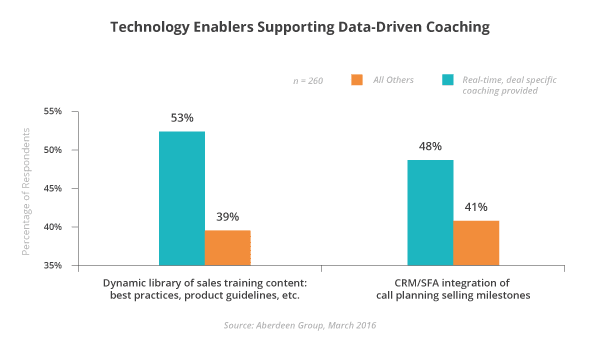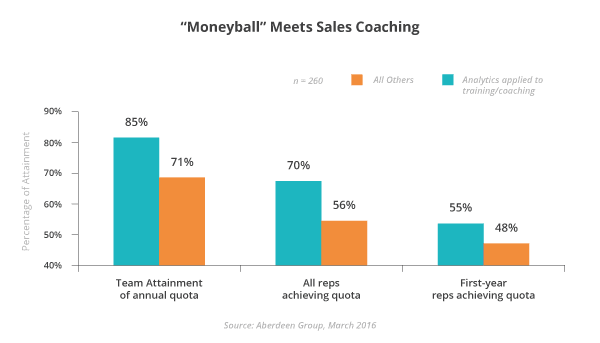Why Data-driven Sales Strategies Work to Turn Prospects into Customers
Selling is no longer about giving lectures or presenting well-crafted powerpoint decks, it’s about helping customers find a solution to their problem. The answer to helping your reps provide a solution based on a customer’s needs doesn’t lie in reams of notes either, it lies in data-driven sales strategies.
New technologies allow you to automate tasks and work smarter, but they also collect data. And data holds the key to your organization transforming its sales strategies. In fact, companies that actively use data have
50% higher growth rates
than those that don’t.
Boosting and retaining knowledge
One of the biggest issues with traditional sales training has to combat is that a
ccording to research
, the average person forgets 50% of the information presented to them. Within 24 hours that becomes 70%, and a week later it’s 90%. Did you know that proven way to improve knowledge retention is through reinforcement?
According to Aberdeen’s research, 26% of companies believe long-term sales learning reinforcement is actually more important than the training. This approach includes ongoing sales learning, which results in out-performance on a number of KPIs compared to those who don’t do this. Data-driven knowledge reinforcement boosts this even further.
Data-driven knowledge reinforcement can involve leveraging data to identify gaps in reps’ knowledge. Once the gaps are identified, knowledge can be reinforced through a variety of methods such as quick quizzes or providing content in real-time. Reps can’t refer to the notes tucked away in a folder in their office when they’re meeting a client. But technology can not only help them access information when they need it, but the data it collects can also help them find the right information and even identify what they need to know.
For example, reps can be served the right information they need for a customer meeting based on what has worked for other reps in a similar situation. Over the coming year, using data to serve more relevant content and leverage best practices of top performing reps will become an integral part of high-performing sales strategies.
Approximately
95% of B2B deals
are influenced by content, but it has to be the right content. Data doesn’t just help reps find the right content, it also gives valuable information to people who create the content to help them understand what is most valuable and the impact that it has on sales performance. This feedback helps them make better content that will continue to improve sales performance.
Improve coaching methodologies
Companies who use analytics-driven sales coaching methodologies can improve their time-to-productivity by 21% according to
research by Aberdeen Group
. This is enabled by technology that helps managers coach on-the-go.
The research also found that top performers are 62% more likely to have real-time coaching for specific deals, opportunities or accounts. By enabling your managers to coach their remote salespeople in real-time on tactical issues they can help them win more deals.
Real-time deal coaching is 35% more likely to be used with dynamic training content. As described above, the data collected by technology can now help you understand what reps need to be coached on and the information they need to be given access to. Together this has the power to improve their performance as they’re speaking to customers.
This can even create an environment where reps’ create a demand for knowledge and draw on it when they need it. The more relevant the learning, the more likely reps will continue to use it regularly. Future sales strategies will be driven by what reps need and demand.

Data can help sales leaders understand what they should be coaching on and when. If they can see that reps are losing deals after their demo, for example, then it may mean they need coaching to help convert those opportunities. This can also help speed up the sales cycle and improve productivity.
Increase success and quota attainment
Where the rubber really hits the road is when you connect the data from your sales readiness technology to your CRM. You can then connect each stage of the sales cycle, all your salespeople’s activity, their pipeline and their results. By bringing this data together, you have the power to identify where reps are winning and losing deals, and what helps them succeed.
Research shows that applying analytics to training and coaching can improve quota attainment from 71% to 85%.
This data can identify gaps, potentially suggest knowledge that would help plug those gaps and flow into an ongoing training program. The information can be used not only at an individual level, but can also help create high performing sales organizations by leveraging best practices from within your own team.
Analyzing data on key metrics at each stage of the process can identify what went wrong and what went right. By identifying best practices you can create repeatable performances that translate into predictable revenue. If you can identify what content and which message can help close deals quicker, this can create a step-change in the performance of all your reps, not just those that have ‘got’ it.
This data can also be used to predict success on a deal by deal basis, making revenue more predictable at an aggregate level. Productivity can improve as the data starts to give reps advice about when they should walk away from a deal and help them identify which deals to focus on.
Crucial to any data-driven strategy is your data – and the quality of your data depends on the tools that you use. From your CRM to sales readiness technology, it’s important to have a sales stack that enables your sales organization to be data-driven. Without it, your transformative sales strategies will fail. The technology must give you data that is accurate and relevant to what you’re trying to achieve.
Selling is complex enough in the modern age, your technology and data should make it simpler for your sales organization not more difficult. That’s why it’s important to find tools that capture, integrate and collate your data in a way that you can use it.
With the right tools and data at your disposal, you’ll have the power to create more powerful sales strategies. This year and long into the future, data will be the key to transforming how your sales organization learns, sells and performs.



